

The
Kamasutra
Our Books
Bhagavad Gita
Gheranda Samhita
Hatha Yoga Pradipika
Kamasutra
Shiva Samhita
The
Kamasutra
The Original Sanskrit
Vatsyayana
An English Translation
Lars Martin Fosse
YogaVidya.com
An important message to our readers:
The ideas and practices in this book should not be followed or attempted. The ideas expressed in this book should not be used to diagnose, prescribe, treat, cure, or prevent any disease, illness, or individual health problem. Consult your health care practitioner for individual health care. YogaVidya.com LLC shall not be liable for any direct, indirect, incidental, special, consequential, or punitive damages resulting from the use of this book.
YogaVidya.com, PO Box 569, Woodstock NY 12498-0569 USA
Copyright ©2012 YogaVidya.com LLC. All rights reserved
Read the Originals is a trademark of YogaVidya.com LLC.
YogaVidya.com is a registered trademark of YogaVidya.com LLC.
First edition
Manufactured in the United States of America
Made possible in part by a grant from Norway’s Nonfiction Literature Fund.
 The paper used in this book meets the requirements of the American National Standards Institute/National Information Standards Organization Permanence of Paper for Publications and Documents in Libraries and Archives, ANSI/NISO Z39.48-1992.
The paper used in this book meets the requirements of the American National Standards Institute/National Information Standards Organization Permanence of Paper for Publications and Documents in Libraries and Archives, ANSI/NISO Z39.48-1992.
British Library Cataloguing-in-Publication Data
A catalogue record for this book is available from the British Library.
Publisher’s Cataloging-in-Publication Data
Vātsyāyana.
The Kamasutra : the original Sanskrit / Vatsyayana ; an English translation [by] Lars Martin Fosse.
Woodstock, NY : YogaVidya.com, 2012.
xvi, 449 p. : ill. ; 23 cm.
Includes index.
Includes Sanskrit and English.
ISBN 978-0-9716466-8-1 (cloth : alk. paper)
ISBN 978-0-9716466-9-8 (pbk. : alk. paper)
ISBN 978-0-9899966-3-1 (ebook)
1. Sex instruction. 2. Sex customs. 3. Love. 4. Sex.
I. Title. II. Vātsyāyana. III. Fosse, Lars Martin, 1950–, tr.
HQ470.S3 V313 2012
| 392.6—dc23 | 2012943505 |
Loretta stirs the drink.
To Ruth
for her patience, love and kindness
Introduction
PART ONE: GENERAL MATTERS
One:Summary of the Guide
Two:The Three Aims of Life
Three:Exposition of the Skills
Four:Lifestyle of the Elegant Man
Five:The Lover and His Companions
PART TWO: SEXUAL INTERCOURSE
One:Sexual Unions
Sexual Intercourse with Regard to Size, Endurance and Temperament
The Variations of Love
Two:Embraces
Three:Ways of Kissing
Four:Forms of Scratching
Five:Biting and Behaviors
Ways of Biting
Behavior Typical of Women from Different Provinces
Six:Positions and Unusual Acts
Different Sexual Positions
Unusual Sexual Acts
Seven:Slapping and Moaning
Eight:Imitation and Techniques
Imitating the Sexual Role of a Man
Sexual Techniques of a Man
Nine:Oral Sex
Ten:Sex: Beginning, Ending, Types, Quarrels
The Beginning and Conclusion of Sexual Intercourse
Different Kinds of Sex
The Lovers’ Quarrel
PART THREE: YOUNG WOMEN
One:Choosing a Bride
Rules of Courtship
Deciding a Match
Two:Winning Her Confidence
Three:Approaches and Gestures
Approaching a Young Woman
Indications through Gestures and Facial Expressions
Four:Advances
Advances a Man Can Make on His Own
Approaching a Man One Desires
Winning a Young Woman by Advances
Five:Stratagems for Weddings
PART FOUR: THE WIFE
One :The Only Wife
Conduct of an Only Wife
Conduct of a Wife Whose Husband is Abroad
Two:The Other Wives
Conduct of the Senior Wife to the Co-Wives
Conduct of the Junior Wife
Conduct of the Remarried Woman
Conduct of an Unloved Wife
Matters Pertaining to the Harem
Conduct of a Man with Several Wives
PART FIVE: OTHER MEN’S WIVES
One:Seducing Successfully
Exposing the Nature of Men and Women
Causes of Resistance
Men Who Have Success with Women
Women Who are Easily Won
Two:Intimacy and Advances
Ways to Intimacy
Making Advances
Three:Examination of Inclinations
Four:Tasks of the Female Messenger
Five:The Erotic Desire of Rulers
Six:Harems and Wives
Life in the Harem
Guarding One’s Wives
PART SIX: COURTESANS
One:Friends and Lovers
The Appraisal of a Friend, Suitable and Unsuitable Lovers, and Reasons for Approaching a Lover
How to Acquire One
Two:Compliance with the Lover
Three:Money, Indifference and Disposal
Ways to Make Money
Signs and Recognition of Indifference
Methods for Driving the Lover Away
Four:Restoring a Broken Relationship
Five:Types of Profit
Six:Profit, Loss, Risk and Types of Available Women
Considering Profit and Loss, and their Consequences and Risks
Types of Available Women
PART SEVEN: ADVANCED METHODS
One:Luck, Spellbinding and Aphrodisiacs
Achieving Luck in Love
Spellbinding Someone
Aphrodisiacs
Two:Passion, Enlargement and Techniques
Recovery of Lost Passion
Enlarging the Male Organ
Unusual Techniques
Contributors
Index
BOTH JUICY and exceedingly dry, sensitive and cynical, ahead of its time and appallingly retrograde, the Kamasutra is the most famous guide to sensual pleasure ever written—indeed, one of the most notorious books in the history of the world. Its acute insights into human nature are still relevant today.
While previous publishers typically either stole the word “Kamasutra” and slapped it on a book of modern photographs, or neglected to include the original Sanskrit, or reprinted an old, faulty translation (or introduced a new, faulty translation), or included reproductions of miniatures made more than a millennium after the text was composed, YogaVidya.com and I have labored mightily to create a proper edition. It includes the original Sanskrit typeset in Devanagari, a new, accurate and readable English translation, and illustrations using period clothing, jewelry, and settings that actually correspond to what is described in the text.
Composed in northern India in the third or fourth century CE at the beginning of the Gupta Empire, the apex of India’s classical civilization, the Kamasutra is the oldest existing Indian text about pleasure. It was a handbook for the urbane man of culture, courtesans, and upper-class women. Painting a vivid picture of life in India, its ideas permeated classical literature. It is a digest of several older works, which in turn were said to draw from a large work by an attendant of the god Shiva, implying a divine origin.
Vatsyayana does not present himself as the original author, but rather one who reorganizes and edits the work of others. He also offers his own arguments and views, positioning himself as the final authority on a number of issues. Surprisingly pragmatic and mostly amoral, Vatsyayana comes to the defense of eroticism and discreetly pokes fun at the ascetics. We know nothing about him. Like so many ancient authors, he vanishes in the mists of time. Only his name remains, perhaps legendary.
A detailed summary of the book can be found in the opening chapter, so I won’t repeat that information here. But knowing a few things now will make this book easier to follow.
A distinctive feature of the Kamasutra is its classification of men and women according to the size of their genitals so couples can combine for maximum pleasure. Positions that work well for couples of equal size may not be as good for couples of unequal size. Several positions try to accommodate unequal sizes by achieving a tight fit by other means, such as using the thighs to produce a good squeeze.
Small, medium, and large genitals go together in different combinations, or unions. The best unions are small with small, medium with medium, and large with large. Union with one size larger or smaller is high or low; union with two sizes larger or smaller is very high or very low.
The genital sizes and their combinations are as follows:
| Man | Woman | Union |
| Hare | Doe | Equal |
| Bull | Mare | Equal |
| Stallion | Elephant cow | Equal |
| Hare | Mare | Low |
| Bull | Elephant cow | Low |
| Bull | Doe | High |
| Stallion | Mare | High |
| Hare | Elephant cow | Very low |
| Stallion | Doe | Very high |
Another notable feature of the text is the “third nature,” which includes everyone who is neither a heterosexual male nor a heterosexual female. While imposing modern categories on ancient phenomena is fraught with difficulties, we can say in the most general terms that, in the Kamasutra, the third nature is primarily composed of biological males engaging in a wide variety of non-heterosexual behaviors. It gives a vivid impression of gay men’s life in classical India.
You may be shocked at the abundance of biting, scratching, and slapping. Slapping causes passionate moaning and screaming on the part of the woman. The point is probably to stimulate the brain’s production of endorphins, which increases sexual ecstasy, just as it does in religious ecstasies.
The age of marriage throughout the ancient world, with its short life spans, was lower than it is today. This explains why the man is told to engage in childish pastimes to win his bride’s confidence. Kind and considerate treatment was meant to create a secure emotional basis for the marriage and a reliable wife who would not reject sex or prefer other men.
Prostitution was very much a part of the entertainment industry of the day. Courtesans lived in a special quarter of the city, either independently or financed by the king. Although roundly condemned by the clergy, courtesans were immensely popular and admired, just like modern celebrities. Indian kings, like their European counterparts, invested in and taxed prostitution—with excellent returns. Since prostitutes were an economic asset, they had some legal protection, although they were otherwise regarded as beyond the pale of respectable society. Among themselves, they lived in a world of reversed status—the women were the most important persons, usually supervised by a stone-hearted older woman, or “mother,” who ran the business. Men had no status and no authority.
Lastly, you may be astonished by the vast amount of intrigue, drama, and suspense. Penetrating another man’s harem and having sex with his wives was dangerous for all involved. Nevertheless, both harem women and other married women had many ways to get sexual satisfaction on the sly. Thus, the urbane man—from merchant to king—had to guard his women against the plots of other men, as well as against the plots of the women themselves and even of their servants. At the same time, he might engage in similar plots, having affairs with married women himself!
As for the structure of the book, the first thing to realize is that it is a sutra text, characterized by highly condensed, almost inaccessible technical language stripped of every unnecessary syllable to ease memorization. (Sutra literally means “a thread” in the sense of a clue or a guide. For a more detailed interpretation, a reader relied on a guru, a commentary, or both.) The editors grouped the individual, numbered threads into paragraphs, but left the numbering unchanged. We left the translation unnumbered to avoid clutter. Some external sandhis were left unmade to help a Sanskrit reader decipher this very difficult text and to reduce hyphenation. In addition to the sutras, there are little groups of verses, typically at the end of a section or chapter, distinguished typographically in the Sanskrit as two separate lines of text. Sometimes they are introduced in the translation with a phrase like “And there are these verses about this” and sometimes not.
Due to its ancient and layered origin, the text has two organizing structures, chapters and sections, running in parallel, which we’ve retained and merged into a modern hierarchy with modern nomenclature. We have followed the traditional practice of pulling chapter and section titles from the colophons, those delightfully flowery sentences that bring each chapter to a satisfying close. Some chapter titles were abbreviated and/or made general enough to describe the entire chapter—check the colophons for the original, unabbreviated titles. The seven parts and their titles are as they were in the original.
I worked hard to make an accurate translation of just the Kamasutra itself. More specifically, I resisted the urge to pad the translation with material from Yashodhara’s commentary, which is almost a thousand years removed from Vatsyayana’s text. I profited from the fine translations of Richard Schmidt, Klaus Mylius, and Wendy Doniger & Sudhir Kakar. Readers interested in the history of the text may enjoy James McConnachie’s The Book of Love: The Story of the Kamasutra.
In the end, what can we make of the Kamasutra?
It contains appalling practices and attitudes—literally too numerous to mention here—that could get you injured, renounced, imprisoned, abandoned, impoverished, or even killed. The cynicism that permeates the text could make you Machiavellian—or worse. Do not blindly use this book as a how-to manual.
On the plus side, it ascribes a deep, positive value to sex: it isn’t simply for reproduction, sexual happiness matters, and it’s important for one’s physical and mental health. The freewheeling, amoral sexuality of the Kamasutra may go too far, but with the application of common sense and critical intelligence lovers may still benefit from its ancient wisdom.
The Kamasutra also gives a fascinating account of human psychology. In his discussion of harem intrigues, seductions, and liaisons, Vatsyayana brilliantly analyses the vulnerabilities and frailties of the human mind. This is where the Kamasutra is truly universal, since his analysis of human nature is still recognizable today anywhere in the world.
Perhaps, then, our challenge is to learn what we can without damaging who we are. Our relationships can benefit from knowing how the body, the mind, and the emotions work. One could even use this knowledge to find and nurture true love.
Part One
General Matters

Chapter One
Summary of the Guide

Homage to religion, prosperity, and sensual pleasure, because these are the central subjects of this guide. And homage to the teachers who explained their connections, because these three are related to each other.
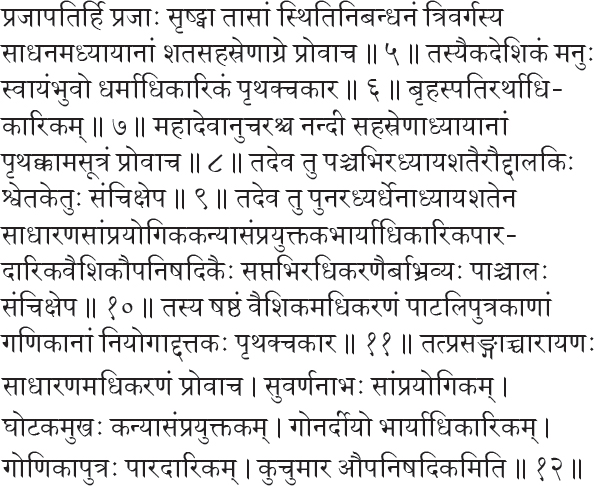
When Prajapati, the Creator, made his creatures, he first proclaimed in one hundred thousand chapters how these three aims of life function as the cause of their existence. Manu, son of the Self-born One, extracted the part dealing with religion as a separate work. Brihaspati did the same with regard to prosperity, and the great god Shiva’s follower, Nandin, made a separate presentation of the guide to sensual pleasure in one thousand chapters. Shvetaketu, the son of Uddalaka, then abridged this to five hundred chapters. And furthermore, Babhravya from Panchala abridged this to one hundred fifty chapters in seven parts: General Matters, Sexual Intercourse, Sex with a Young Woman, the Role of the Wife, Other Men’s Wives, Prostitution, and Advanced Methods. From this Dattaka, commissioned by the courtesans of Pataliputra, extracted the sixth part on prostitution as a separate work. Responding to this, Charayana adapted the part on general matters, Suvarnanabha the part on sexual intercourse, Ghotakamukha the part on sex with a young woman, Gonardiya the part on the role of the wife, Gonikaputra the part on other men’s wives, and Kuchumara the part on advanced methods, all as separate works.

In this manner, the guide was divided into pieces by many teachers and its precepts nearly vanished. Because the parts of the work made by Dattaka and the others were one-sided, and because Babhravya’s work was too big to be memorized, Vatsyayana abridged the whole subject into a small book and presents it as this guide to sensual pleasure.

This is the description of its chapters and sections.
The first part, General Matters, has five chapters with five sections: Summary of the Guide; Achievement of the Three Aims of Life; Exposition of the Skills; Lifestyle of the Elegant Man; and Examination of the Activities of the Lover, His Companions, and Messenger Women.
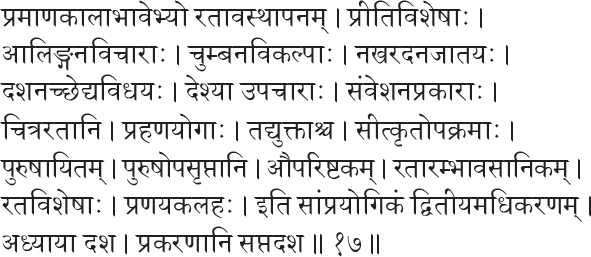
The second part deals with sexual intercourse. It has ten chapters with seventeen sections: Sexual Intercourse with Regard to Size, Endurance, and Temperament; Variations of Love; Embraces; Ways of Kissing; Forms of Scratching; Ways of Biting; Behavior Typical of Women from Different Provinces; Different Sexual Positions; Unusual Sexual Acts; Techniques of Slapping and the Manners of Moaning Associated with Them; Imitating the Sexual Role of a Man; Sexual Techniques of a Man; Oral Sex; The Beginning and Conclusion of Sexual Intercourse; Different Kinds of Sex; and The Lovers’ Quarrel.

The third part deals with sex with a young woman. It has five chapters with nine sections: Rules of Courtship, Deciding a Match, Winning a Young Woman’s Confidence, Approaching a Young Woman, Indications through Gestures and Facial Expressions, Advances a Man Can Make on his Own, Approaching a Man One Desires, Winning a Young Woman by Advances, and Stratagems for Weddings.

The fourth part deals with the wife. It has two chapters with eight sections: Conduct of an Only Wife, Conduct of a Wife Whose Husband is Abroad, Conduct of the Senior Wife to the Co-wives, Conduct of the Junior Wife, Conduct of a Remarried Widow, Conduct of an Unloved Wife, Matters Pertaining to the Harem, and Conduct of a Man with Several Wives.

The fifth part deals with the wives of other men. It has six chapters with ten sections: Exposing the Natures of Men and Women, Causes of Resistance, Men Who Have Success with Women, Women Who Are Easily Won, Ways to Intimacy, Making Advances, Examination of Inclinations, Tasks of the Female Messenger, The Erotic Desire of Rulers, and Life in the Harem and Guarding One’s Wives.

The sixth part deals with courtesans. It has six chapters with twelve sections: Appraisal of a Suitable Lover; Reasons for Approaching a Lover; How to Acquire One; Compliance with the Lover; Ways to Make Money; Signs and Recognition of Indifference; Methods for Driving the Lover Away; Restoring a Broken Relationship; Types of Profit; Considerations Concerning Profit, Loss, and Their Consequences and Risks; and Different Kinds of Available Women.

The seventh part deals with advanced methods. It has two chapters with six sections: Achieving Luck in Love, Spellbinding Someone, Aphrodisiacs, Recovery of Lost Passion, Enlarging the Male Organ, and Unusual Techniques.

That was the summary of this handbook. There are thus seven parts, thirty-six chapters, sixty-four sections, and 1,250 sutras. After this brief exposition, a detailed description of the matter follows, for the world of the learned wants both a summary and a detailed account.

Thus ends the first chapter, Summary of the Guide, in the first part, General Matters, in the guide to sensual pleasure by the glorious Vatsyayana.

Chapter Two
The Three Aims of Life

A man may truly live for a hundred years. By dividing his time, he should pursue the three mutually connected aims of life in such a way that they don’t cause damage to each other.

In childhood, he should strive for goals such as the acquisition of knowledge; in youth, sensual pleasure; and in old age, religion and release. Or he should pursue these aims as the situation permits, since his lifespan is uncertain, but remain celibate until his studies are finished.

Religion is the performance, according to scripture, of acts such as sacrifices and so on, which have no practical purpose because they are not of this world and their aims are invisible, and avoiding, again according to scripture, acts such as the consumption of meat which have a practical purpose because they are of this world and have visible aims. He should learn about it from received scripture and through association with religious experts.

Prosperity is the acquisition of things such as knowledge, land, gold, cattle, grain, merchandise, equipment, and friends, and the increase of what has been acquired. It is learned from the conduct of officials and from merchants with knowledge of business practices.

Sensual pleasure means the application of hearing, feeling, sight, taste, and smell to their separate objects, according to one’s wishes, based on the mind united with the self. Specifically, sensual pleasure is the self’s successful experience of a sense object, permeated by a psychological pleasure caused by the object of the different sense impressions. This he should learn from this guide to sensual pleasure and through association with the elegant men of the town.

When these three aims of life are in conflict, the preceding aim in the sequence is always the most important. But for the king, the most important aim is prosperity, because social life is rooted in it, and the same goes for a prostitute.
So far the achievement of the three aims of life.
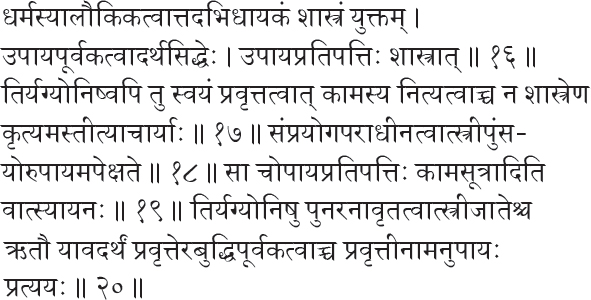
Religion is not of this world, therefore a book which teaches it is appropriate. The same goes for success in prosperity, because it depends upon methods. These methods are taught by a manual. According to the teachers, however, among animals action is produced by impulse and the innate character of sensual pleasure, not from a manual. Because men and women depend upon another for sexual intercourse, sensual pleasure demands a method. And, according to Vatsyayana, one learns this method from this guide to sensual pleasure. Animals, on the other hand, have intercourse because the females roam freely, because it happens in the fertile season according to need, and because they mate without thinking. Thus there is no need for a method.

“He should not pursue religion because the fruit comes in the future, and because it is uncertain. For who but a fool would hand over what he holds in his hand to another? Better a pigeon today than a peacock tomorrow. A sure copper penny is better than an unsure ornament of gold.” So say the materialists.
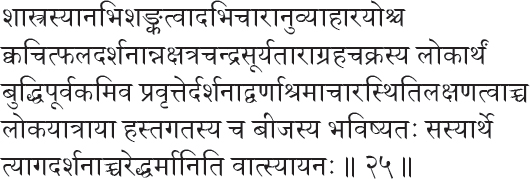
But Vatsyayana says: “Because scripture cannot be doubted, and because the fruit of incantations and curses can occasionally be seen; because one can see that the constellations, the moon, the sun, the stars, and the circle of planets act for the sake of the world as if intentionally; because social life is marked by the maintenance of the practices of the classes and stages of life, and because one sees that a piece of grain in one’s hand has to be cast away so that it can become corn, one should act according to religious principles.”
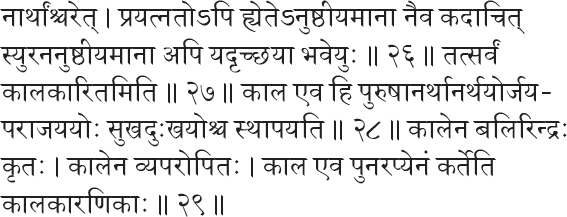
“One should not pursue economic matters. For even if one attends to them with great effort, sometimes nothing comes of them, and even if one does not attend to them, they may produce results by themselves. Fate makes all this happen. For it is fate that leads men to wealth and misery, to victory and defeat, to happiness and unhappiness. Fate turned Bali into Indra. Fate toppled him. Only Fate will reinstate him.” So say the fatalists.

“Because all activities are based on human effort, there is a need for a method, precisely because even wealth inevitably ordained is associated with a method. The person who doesn’t act achieves nothing good,” according to Vatsyayana.
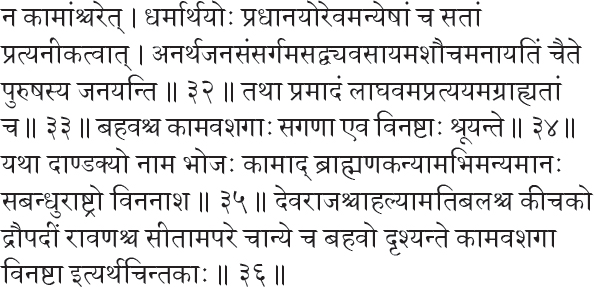
“One should not pursue sensual pleasures, because they militate against religion and prosperity, which are the most important, but also against other good things. Furthermore, they bring a man into contact with worthless people, cause him to participate in bad undertakings, and produce impurity and loss of prospects. They also produce carelessness, thoughtlessness, distrust, and rejection. And we hear of many who, under the spell of sensual pleasure, have perished with their followers like Dandakya, the king of the Bhojas who, for reasons of sensual pleasure, desired the daughter of a Brahmin and perished with his kinsmen and his realm. The King of the Gods desired Ahalya, the all-powerful Kichaka desired Draupadi, Ravana desired Sita, and many others under the spell of sensual pleasure are seen to have perished,” according to the utilitarians.

“Sensual pleasures actually resemble food because they make the body thrive, and they are the fruits of religion and prosperity. But we must also be aware of their disadvantages, as it were. For we do not fail to put cooking pots on the fire without thinking, ‘There are beggars,’ nor do we fail to sow barley without thinking, ‘There are gazelles,’” according to Vatsyayana.

And there are these verses about this.

A man who pursues prosperity, sensual pleasure, and religion achieves endless happiness without pain, both in this world and the next.

Educated men prefer actions which are neither associated with doubt about what will happen in the next life, nor with happiness that destroys prosperity.
One should perform an action that achieves the three aims of life, or two of them, or only one, but not one that prejudices the other two.

Thus ends the second chapter, Achievement of the Three Aims of Life, in the first part, General Matters, in the guide to sensual pleasure by the glorious Vatsyayana.